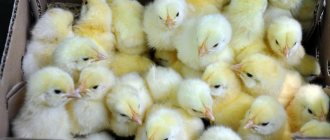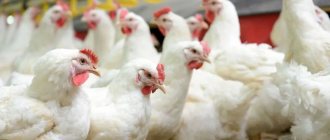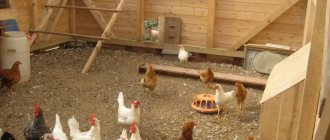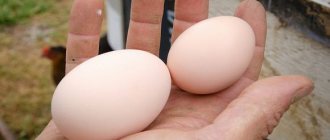Broiler breeding: the best breeds
- Broiler chickens are not the name of a separate breed. This is a hybrid bred by crossing the meat breeds of rooster and chicken. Since the breeds were bred as meat birds, such birds quickly gain weight (literally a month and a half after birth). In addition, they are quite unpretentious and do not require significant care.
- Preference should be given to breeding for meat rather than for eggs and breeding chickens, since for a novice businessman this is a rather labor-intensive and costly activity, which is unlikely to become profitable without the proper experience.
Chicken
The most successful business is if you have your own plot of land, which will keep initial costs to a minimum. So, you should consider the following breeds for breeding broilers:
- ROSS-308 is a unique white breed with high productivity, gaining up to 400 g in weight per week and reaching about 2.5 kg by the time of slaughter (which is one and a half to two months). Egg production is up to 185 eggs, which is a fairly high indicator.
- COBB-500 is an intensively growing breed of yellow color, which is inherent in the bird regardless of the pigmentation of the feed. She is usually put under the knife at the age of about one and a half months, when she reaches 2.5 kg.
- Broiler-M - small chickens and synthetic males form the basis of this breed, bred as a hybrid of the Yerevan red and mini chickens. Quite picky and productive in both meat and egg production (over 160 eggs), the bird’s weight reaches 3 kg.
- Broiler-61 is a breed created by double crossing Cornish and Plymouth Rock on the rooster and hen sides, respectively. It quickly gains weight by one and a half months and reaches almost 2 kg), has an average egg production, and good survival rate. Disadvantages include slowly strengthening bones with rapid weight gain.
- Gibro-6 is also a four-line breed. It grows quite quickly, reaching 1.5 kg by one and a half months; from 30 to 80 g are added per day. Egg production is lower than that of other breeds, the skin and subcutaneous fat are yellow. Survival rate is high.
- The change is the result of crossing two previous broiler breeds and grows quite quickly. They have an average egg production (up to 140 eggs), are quite viable, and have high egg and meat qualities.
Selection of eggs and chicks
For raising healthy, large chickens, hybrid breeds obtained as a result of crossing will be optimal. The most productive of them are Ross -308, Cobb-500, Smena-7.
To purchase chickens, contact only trusted suppliers. Take chicks at least 10 days old, with feathers lying evenly, without clouding of the eyes, and active. The wings should fit tightly to the body and not puff up.
As for the eggs, they should be approximately the same size, with uniform pigmentation, and even. You can also conduct an examination with an ovoscope. You should pay attention to:
- The presence of a dark spot - an embryo.
- The position of the yolk should be in the center. And only one.
- The air chamber should be no more than 1.5 cm in size.
A repeat examination with an ovoscope occurs after a week. Another one - 2-3 days before the chicks hatch. At the final stage, the air chamber occupies at least 75% of the egg, and there should be practically no protein.
You should not buy chicks at spontaneous markets - the risk of acquiring sick birds is very high.
How to breed broilers at home: a business plan for beginners
- Registration of a poultry farm. The need for it depends on whether you will make wholesale deliveries or limit yourself to friends and acquaintances. But the latter option is absolutely not profitable, and the first one will indeed require registration, since not a single wholesale buyer will purchase goods without first concluding an agreement. And for this, of course, you need to register your business.
- Veterinary certificates. In the case of breeding broilers without documents from the veterinary service and certificates signed by specialists of the sanitary and epidemiological service, you will not be able to check the quality and confirm it with the appropriate certificates. But given the small batches of meat, you won’t need to engage in branding.
- Method and place of raising chickens. You need to decide and choose what suits you best: a chicken coop or cages. The first method is good for poultry due to its spaciousness, but will require investment in the construction of a poultry house. The second is less expensive (without construction), but complicated by the need for constant temperature conditions, which involves additional costs for electricity. And the purchase of enclosures should also be included in the business plan. Typically, the space required for maintenance is calculated based on 1 m² for 10-12 broilers.
- Chicken coop equipment. Purchasing complex equipment (with incubators, heating and air purification, grain crushers, etc.) only makes sense when you are going to organize an entire poultry farm - then the initial investment subsequently has a chance to pay off. If your plans include only a small poultry house, then simple and inexpensive equipment in the form of heaters, thermometers, feeders, drinkers, etc. is sufficient. It’s the same with the premises – you can use an empty barn for it.
- Purchase of poultry. A cheaper option, of course, is to buy eggs, but you need to calculate whether you can afford an incubator for them and whether you can provide all the necessary conditions. You should also take into account the risk of purchasing obviously low-quality eggs. Less risky in this regard is the purchase of young animals, but even here it is important to carefully examine the chickens you are going to buy and make sure that they are not sick.
Consider the disadvantages and advantages
Little or grown up - Purchase of feed. Broilers grow very quickly; in just a couple of months they develop from an embryo in an egg to an adult, so you should take into account the appropriate amount of feed for different age categories of birds. You can try and prepare your own bird food.
Paperwork
First of all, you need to decide on the form of ownership and register with the tax authority.
IP
Suitable for those who plan to do business and be responsible for everything on their own.
To register you will need:
- Statement of the established form.
- Copy of the passport.
- Receipt for payment of state duty.
OOO
Suitable for those who create a business together with a partner.
To register you must provide:
- Application for registration of a legal entity.
- Copies of passports of all founders.
- Charter of a legal entity.
- Protocol on the establishment of a legal entity.
- Agreement on the establishment of an LLC (not necessary if there is only one founder).
- Receipt for payment of state duty.
peasant farm
Peasant farming is a special form of farming. Gives the right to use various benefits and subsidies from the state, however, the head of a peasant farm cannot act in personal interests, but only in the interests of all members of the farm.
To open a peasant farm you will need:
- Unified form application.
- Peasant farm members agreement.
- Copy of the passport of the head of the household.
- Receipt for payment of state duty.
Broiler breeding: chicken coop equipment
- In addition to a durable stone floor, which will prevent mice and rats from entering the chicken coop, the room must be well ventilated. This is necessary to ensure that there is no concentration of ammonia vapor, thereby providing a favorable microclimate and protecting the room from high humidity.
- As for lighting, this is a necessary component. Darkness is not suitable for the growth of chickens, so care must be taken to purchase lamps (preferably blue or red, since the bird is too sensitive to bright light and experiences discomfort from it). To save on energy costs, many people install a window in the room, which provides a source of light during the daytime.
- And, of course, you should take care of the heat source when breeding broilers. Of course, there is no need to install central heating in the chicken coop, but it is necessary to provide an option such as a potbelly stove, since spring frosts are a very real thing.
Chicken coop equipment
- If a cage-based housing option (it is preferable for meat breeds), cages are needed. In addition, they promote higher hygienic living conditions by having trays at the bottom in which droppings are collected.
- Cages can be placed in several tiers, which will allow you to increase the number of animals without expanding the area. And most importantly, you can make the cells yourself, which will reduce initial costs.
Personnel
A small farm of 500 birds can be managed by 2-3 people. This business is often organized as a family business. If you plan to grow crops for food yourself, you can hire seasonal workers to perform certain jobs.
Broiler breeding: bird care
- If your poultry house is not for a dozen birds, but for 20-50, then it is better to plan for at least one more person to participate in the work. Perhaps family members will help you, and if funds allow, it makes sense to invite an assistant to breed broilers. In addition to regularly feeding the birds, it is necessary to clean the premises at least regularly.
- For newly hatched chicks, it is necessary to maintain the temperature at least 30˚C, lowering it as the birds grow older. A chicken coop or cage is enough for them, so free range is unnecessary. Birds are also afraid of drafts, so make sure there are none when you set up the ventilation system. Don't forget to add fresh sawdust or straw to the floor.
- The survival rate of broilers is generally high. But examining the chickens by a veterinarian will not be superfluous. Moreover, before slaughtering a bird, you must be sure that it is healthy and all necessary veterinary examinations will be passed without problems.
Preparation for sale
Broiler breeding as a business requires a production cycle of about 70 days. When the birds have reached two months of age, they can be slaughtered. It is better to hire a third-party employee for this purpose. Before slaughter, birds are not given food for 10-12 hours. Catching should be done carefully so as not to cause injury or cause stress. You must proceed as follows:
- Stun and kill a bird
- Perform exsanguination
- Pluck and gut the carcass
- Singe and rinse
- Package and label products
- Freeze
Broiler breeding: diet
- Feeding of day-old young animals is carried out after 3 hours , starting feed is used for this. Then, as the young animals grow, the feed is replaced with a composition that promotes intensive weight gain, and final fattening is carried out with a finishing mixture.
Stern
- Feeding of grown-up individuals, when breeding broilers, is carried out twice (sometimes three times) a day. On average, for every kilogram of weight gain, about 2 kg of feed is consumed.
- Already in the second week, you can make grain the basis of your diet , while not forgetting that ready-made mixtures are also necessary (at least once a day). When you select a composition that is completely balanced, you can switch to natural feed mixtures, in which half is corn, a third is barley, the rest is barley and millet in equal proportions.
- And, of course, vitamins and mineral supplements are important. Sand is replaced with small shells, and they do not forget to enrich the diet with greens, which can amount to up to half of the total daily requirement.
Feeding
A business plan for breeding boiler chickens involves choosing a diet. Broiler nutrition plays a key role in generating further profits. The diet is divided into three main stages, namely:
- Pre-launch
- Starting
- Finishing
The first stage lasts 2 weeks, during this period the chickens are fed with a special mixture, gradually increasing the daily intake from 10 to 25 grams.
The starting period lasts until the end of the first month, at which time the portion is increased to 120 grams. Then, until the end of the second month, the daily portion is 130-150 grams of feed.
If you are planning to make raising broilers your business, then you should not experiment with feed - it is better to purchase ready-made feed, which contains everything necessary for healthy growth and active weight gain. The amount of feed should also be sufficient. Cutting portions can have a bad effect on the weight gain of birds.
Despite the fact that broilers are not very susceptible to all kinds of infections, it is necessary to adhere to hygiene measures: keep the bedding, drinkers, feeders clean, and periodically add fresh grass to the chickens’ diet. On a household scale this is easy.
Broiler breeding: payback
- Broilers were originally bred as meat breeds. Therefore, broilers are bred primarily for meat. A bird can reach three kilograms (and in some breeds more) in just one and a half to two months. It is the speed of weight gain that allows you to recoup your investment after this time.
- The convenience of such a business is also that during the season you have the opportunity to raise several flocks of poultry. Of course, the initial investments (building a chicken coop, purchasing the necessary equipment, etc.) will be more significant, but they are made once, and it makes sense to purchase high-quality products for construction in order to subsequently avoid the cost of repairs.
Profit
Advantages and disadvantages
Although broiler breeding as a business is a fairly promising niche, this type of business has both advantages and disadvantages. The most important advantages are the rapid growth of chickens, as well as the ability to use a small room. For 1 sq.m. area can accommodate as many as 20 birds.
Of course, there are certain risks:
- Infection of birds with various infections
- Insufficient weight gain due to the use of low-quality feed
- Falling demand for chicken meat
To avoid troubles, you should purchase eggs only from trusted suppliers, having discussed all the nuances in advance and drawn up contracts. Chickens should be purchased only from well-established hatcheries.
Broiler breeding: how to find buyers?
- When breeding broilers, you also need to think about this in advance. The more advantages you have, the more buyers you can attract. Therefore, if possible, organize delivery methods and offer for sale broiler carcasses that are as prepared for cooking as possible.
- You can start by advertising in local newspapers and on television. This way you can attract restaurant business enterprises, possibly meat processing plants located nearby, and also resellers. Your products may also be of interest to those who live nearby and want to periodically buy fresh poultry meat, thus becoming your regular customers. You can sell the products yourself, or by hiring a salesperson.
- to sell broilers in the form of stew , except to acquaintances. Stores will not accept products that have not passed GOST certification and all sorts of approvals. Therefore, if you decide to purchase an autoclave for preparing stew, count on low power, mainly for yourself.
Sale
Main risks
The main danger is exposure of chickens to diseases (bird flu, helminthiasis, pasteurellosis, pullorosis, coccidiosis). Insurance will help reduce risks; you can use one of the programs developed for farms. Purchasing chickens in specialized nurseries, using vitamins and vaccination will slightly increase the cost of chicken meat and eggs, but will allow you to avoid significant losses due to mass mortality of poultry on your farm.
The unpredictable behavior of grain prices seriously complicates the work. They make up the main part of the poultry diet. It is not difficult to minimize losses if you have your own plot and grow your own cereal crops.
Profitability of broiler breeding
On average, the calculation can be made on the example of a farm with a thousand animals. The purpose of broiler breeding is meat production.
- Let's start with the initial lease. On average, it takes about two months to grow, which is 40 thousand rubles.
- The purchase of all equipment will cost 150 thousand, and another 20 thousand rubles for its installation.
- Work on lighting the chicken coop and ventilation - 80 thousand rubles.
- Complete all necessary documents – 15 thousand rubles.
- Purchasing an incubator costs about 55 thousand rubles.
- Buying eggs will cost 10 thousand rubles.
- Salary, utility costs, transportation costs – 50-55 thousand rubles.
- Purchasing the necessary feed will cost 35 thousand rubles.
- Payment of taxes on sales – about 1000 rubles.
To start
For a month
, add another 10 thousand for all sorts of unaccounted expenses, and in the end we will get the required starting amount of about 500 thousand rubles.
- Now let's calculate the revenue. The wholesale price of broiler meat is about 150 rubles. for 1 kg, i.e. from sales (taking into account possible loss) the average amount is 150 thousand rubles.
- Let us subtract monthly expenses from it, and thus obtain net profit, which is about 50 thousand rubles.
- If you receive a similar profit every two months, then in an average year, provided you expand your business, you will be able to make it profitable.
Required documents
To open such a business, you can use either an individual entrepreneur or an LLC. If you do not plan to expand, then it is enough to open an individual entrepreneur. It will cost less and take less time. It is more profitable to choose a simplified form of taxation.
You will also need to obtain permission from the following regulatory authorities:
- Rospotrebnadzor.
- SES.
- An organization that deals with veterinary quality control.
Breeding broiler chickens for meat
- In principle, broilers are intended as a meat breed, although some owners combine raising them for meat and eggs. You can start breeding in two ways: either purchase hatching eggs and wait for the chicks in your own incubator, or buy young animals directly - aged from one to seven days. Both methods have their risks - buying both a spoiled batch of eggs and sick young animals.
- For those who are provided with the conditions to keep an adult purebred bird, there is another way: to breed chickens themselves.
- It is most profitable to raise broilers if you have your own poultry farm and transport, and even more successful will be the care and sale of poultry without the involvement of hired workers - there are no costs for wages, rent, etc.
- Correctly drawing up a business plan that takes into account all possible costs will help not only generate income, but also make it stable. All sales possibilities should be provided for in advance, since keeping broilers for more than 3 (for some breeds - 4) months becomes unprofitable: the heavier the carcass, the more hassle it will be to sell it.
Raised for meat
About business
As a business, broiler breeding is one of the most profitable branches of livestock farming, since the period of raising chickens lasts about 70 days, while cattle must be raised for at least 1-2 years. Large farms specializing in poultry usually develop in the following directions:
- Incubation and rearing of chicks
- Breeding new breeds of birds
- Creation of compound feeds
- Sale of meat and by-products
Moreover, benefits can be obtained even with very small deposits. The easiest way to do this is to raise day-old chicks from eggs. This will already bring benefits, because a day-old chick costs three times more than an egg (25 rubles and 8 rubles, respectively). When you have accumulated a certain starting capital in this way, you can arrange everything for raising broilers.
Breeding broiler chickens in cages
- This type of broiler breeding has its advantages: the space required for breeding, electricity and feed are saved. Broilers are protected from the influence of the external environment, they are easy to care for, and in addition, it is in the cage that they quickly gain the required weight.
- A square meter of cage can accommodate about 25 birds, and given that the cages can be installed, up to 25 broilers can be placed, and taking into account the installation of such cages in several rows, the costs of lighting and heat are reduced. When keeping cages, automatic drinkers and removable trays are used, into which feed is poured - thus the feeding process does not bother the broilers.
- The bird cannot scatter the feed when it is in the feeder, thus there are savings in feed. Cleaning is also easier - it’s easier to clean droppings from a retractable tray than from the litter.
- Keeping them in a cage eliminates the risk of predation or avian disease that can come from contact with wild birds. The factor of adverse weather influences is also excluded.
- Of course, there are also disadvantages: a sick bird can infect everyone around it, since broilers are crowded in cages. For the same reasons, careful control over temperature and air humidity is necessary, since failure to comply with the necessary indicators increases the possibility of disease in the entire livestock.
- And rapid weight gain in birds kept in a cage does not prevent a decrease in the taste of meat compared to free-range birds.
- The cages themselves consist of steel bars on wooden or metal frames. The larger the livestock, the greater the need for a metal frame, which is easy to disinfect. Their optimal width for your own household is up to 70 cm, depth – up to 30 cm, height – up to 25 cm.
In a cage
- You can heat the room with gas, electricity or infrared emitters, which are the most acceptable in this type of household, since they do not require large amounts of electricity and do not require many permits, like gas heating.
- The temperature in the room gradually decreases from 34°C (when chickens are 1-5 days old) to 18-24°C (after reaching 12 days of age). The same principle is used in lighting: from around the clock for week-old chicks to 15-18 hours for older ones.
Room
The poultry breeding premises must be located at a distance from residential buildings, be suitable for comfortable housing for broilers and comply with all sanitary standards.
- For 100 individuals, the area of the room must be at least 10 sq.m. For 2-3 utility rooms, 5-7 sq.m. is enough.
- The walls of the chicken coop must be plastered with lime. This prevents the growth of bacteria.
- You can use straw, shavings or sawdust as bedding for chickens.
- The building must have a well-functioning ventilation system.
- The concentration of harmful substances (ammonia, carbon dioxide and others) must be within normal limits.
- Place drinking bowls and feeders at a convenient distance so that you can easily clean and fill them. For drinkers, the width per individual is 1-3 cm, and for feeders - 6-8 cm.
- Birds do not like cold: this must be taken into account when arranging a chicken coop. Take care of heating the room during the cold season.
Breeding broilers in the country
- In the summer, you can try raising broilers at your own dacha. For this, many people use two cardboard boxes connected together, in one of which a heating lamp is installed for the chickens, and in the second - a feeder with a drinker.
- In the first seven days after purchase, babies are fed boiled eggs, millet porridge without salt, cottage cheese and starter feed. You can give finely chopped greens. It is better to drink sweetish water and skim milk.
- Upon reaching two weeks of age, add egg shells, after calcining them, and whey. It is also advisable to add chalk, fish meal, and nutritional yeast.
- Then the chickens are transferred to cages or to a chicken coop, for which any outbuilding with a wooden floor can be adapted at the dacha, filling it with sawdust and ash or chopped straw, hay and even peat.
- The diet and required temperature indicators are the same as in other methods of breeding broilers. You can add crops grown at your summer cottage to the feed: zucchini, pumpkin, potatoes, carrots, raw or boiled, grated.
- It is important to ensure that the food does not turn sour, and if this happens, it should be thrown away immediately and the feeder should be disinfected with potassium permanganate.
- After one and a half to two months, you can start selling, since the weight of the bird will no longer increase significantly and you will waste money on feed. In addition, if your summer house is used year-round, you can leave some of the birds to hatch eggs and get subsequent generations without spending a lot of money.
At the dacha
And one more tip: you can sell not only meat, but also entrails (liver, stomachs, hearts), paws and heads, sell feathers and even droppings, which produce excellent organic fertilizer, which is very much in demand in dacha conditions.
Sales of products
Before you start your own business and figure out whether raising chickens is profitable or not, you must take care of sales channels. You can sell meat at city markets, various fairs, sell your products to meat shops, or trade directly from the farm. Each of these options has its own nuances.
As an additional income, you can consider selling eggs and day-old chicks. The main thing to remember is quality, a good reputation and competent advertising. This will help you find new customers and expand your audience.











